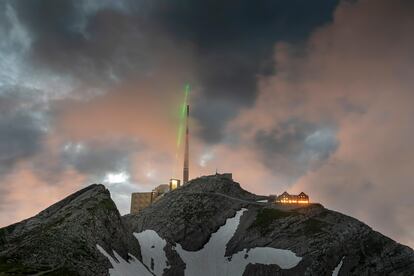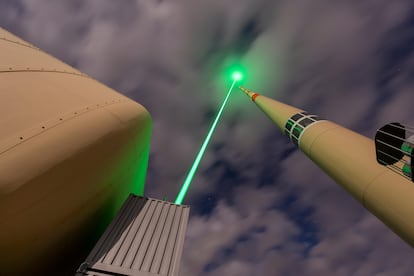Powerful new laser redirects lightning bolts
The Laser Lightning Rod project is the first successful innovation since Benjamin Franklin’s famous invention almost three centuries ago

In June 1752, Benjamin Franklin invented the device that has protected people and buildings from lightning strikes ever since. While he was inventing the lightning rod, the Boston-born statesman and intellectual also demonstrated that clouds are charged with electricity by flying a metal-framed kite with a key attached, which attracted a lightning discharge. Metal rods on rooftops that attract and conduct lightning to the ground where it is neutralized have saved thousands of lives and critical facilities over the centuries. On January 16, Nature Photonics published a study by 28 scientists that demonstrated the first major advance in lightning protection methods since the Franklin rod – a powerful laser that can redirect lightning.
The device fires short and intense laser pulses to generate an ionized channel in the sky called a laser-induced filament that can guide lighting discharges away from vulnerable sites. “By firing a thousand laser pulses per second into the clouds, we can safely discharge lightning bolts and make the world a little safer,” says Clemens Herkommer, an engineer at TRUMPF Scientific Lasers and participant in the Laser Lightning Rod (LLR) project.
The device, which is the size of a large family car, was installed and tested on Säntis Mountain in northeastern Switzerland next to a 400-foot (123 meters) telecommunications antenna. “Since the tower is struck by lightning 100 times every year, we were able to measure the electrical charge that is transferred from the cloud to the ground,” says Marcos Rubinstein, a physicist at the University of Applied Sciences in Lausanne (Switzerland). It was the ideal environment for demonstrating that their laser lightning rod is capable of deflecting lightning bolts away from the tower.
“We measured these electromagnetic fields to understand how the physical mechanisms work and to validate our model,” says scientist Farhad Rachidi. LLR project coordinator Aurélien Houard said: “Using the laser, we can project energy over a long distance in order to create a new path for the lightning bolt. We empty the air using very powerful laser pulses that guide the lightning bolt in a different direction.”
Experiments using intense laser pulses to guide lightning have been conducted before in New Mexico (USA) in 2004 and in Singapore in 2011, but they were unsuccessful in redirecting lightning strikes. The LLR project scientists believe that their success comes from the “higher laser repetition rate… During filamentation [the generation of the ionized channel], a small fraction of the free electrons created by high-field ionization is captured by neutral oxygen molecules. At high laser repetition rates, these long-lived charged oxygen molecules accumulate, keeping a memory of the laser path.” Herkommer adds, “This laser lightning rod is currently one of the most powerful of its type.”
An experiment conducted for six hours on the Säntis summit during thunderstorms less than two miles (three kilometers) away succeeded in guiding an upward negative lightning leader over a distance of 164 feet (50m),which was recorded by two separate high-speed cameras. The guiding of negative lightning leaders by laser filaments was corroborated in three other instances by very-high-frequency interferometric (interference of waves) measurements.
Although the paper concludes that more research and experimentation is needed, this work paves the way for new atmospheric applications of ultrashort lasers and represents an important step forward in the development of laser-based lightning protection for airports, launchpads or large infrastructures.

Satellite data indicates that there are 40-120 lightning bolts every second in the atmosphere. While protection using devices like the laser lightning rod is important, so is the ability to anticipate lightning strikes. To this end, researchers at the École Polytechnique Fédérale de Lausanne (EPFL) have developed an artificial intelligence system to predict them.
The EPFL model enables the prediction of lightning strikes in an 18-square-mile area (30 square kilometers) within 10-30 minutes and with a 20% margin of error. According to Amirhossein Mostajabi, who participated in developing the prediction model and in the laser research, the system “is slow, very complex and requires expensive radar and satellite data.”
The next-oldest method of dealing with lightning after Franklin’s invention is a rocket attached to a long, grounded, conductive cable that was first tested in 1965 to artificially trigger lightning discharges. When launched at the right time, the rockets could attain 90% success rates. But the method is expensive and dangerous because of the rocket fallout and debris. The use of lasers was first considered in 1999, but has been unsuccessful until now.
According to the LLR study “the filamentation process can be controlled so that it starts up to a kilometer [0.6 miles] away from the laser source. It is therefore conceivable that filamentary channels can serve to guide and possibly even trigger lightning discharges under appropriate weather conditions.”
Every day there are about 8.6 million lightning strikes around the world, each travelling at speeds of 200,000 miles (320,000km) per hour and generating large amounts of electricity. “Improving lightning protection is very important now because of the extreme weather events caused by climate change,” says John Lowke, a research professor at the University of South Australia who did not participate in the LLR project.
Abdullah Kahraman, a climate change researcher at the University of Newcastle (UK), recently published a paper in Environmental Research Letters on how global warming is changing the distribution of thunderstorms in Europe. “More frequent lightning strikes over mountains and in northern Europe could trigger more forest fires in high-altitude forests. We are going to see relatively less lightning risk in the more populated areas of central Europe.”
Lowke has researched the role of oxygen molecules in lightning, which is key to LLR’s work in understanding lightning behavior. According to a paper he published in Applied Physics, lightning occurs when electrons strike oxygen molecules with sufficient force to create more molecules of this high-energy element. “We need to understand how lightning is triggered so we can find better ways of protecting buildings, airplanes, skyscrapers and people,” he says.
Sign up for our weekly newsletter to get more English-language news coverage from EL PAÍS USA Edition
Tu suscripción se está usando en otro dispositivo
¿Quieres añadir otro usuario a tu suscripción?
Si continúas leyendo en este dispositivo, no se podrá leer en el otro.
FlechaTu suscripción se está usando en otro dispositivo y solo puedes acceder a EL PAÍS desde un dispositivo a la vez.
Si quieres compartir tu cuenta, cambia tu suscripción a la modalidad Premium, así podrás añadir otro usuario. Cada uno accederá con su propia cuenta de email, lo que os permitirá personalizar vuestra experiencia en EL PAÍS.
¿Tienes una suscripción de empresa? Accede aquí para contratar más cuentas.
En el caso de no saber quién está usando tu cuenta, te recomendamos cambiar tu contraseña aquí.
Si decides continuar compartiendo tu cuenta, este mensaje se mostrará en tu dispositivo y en el de la otra persona que está usando tu cuenta de forma indefinida, afectando a tu experiencia de lectura. Puedes consultar aquí los términos y condiciones de la suscripción digital.









































